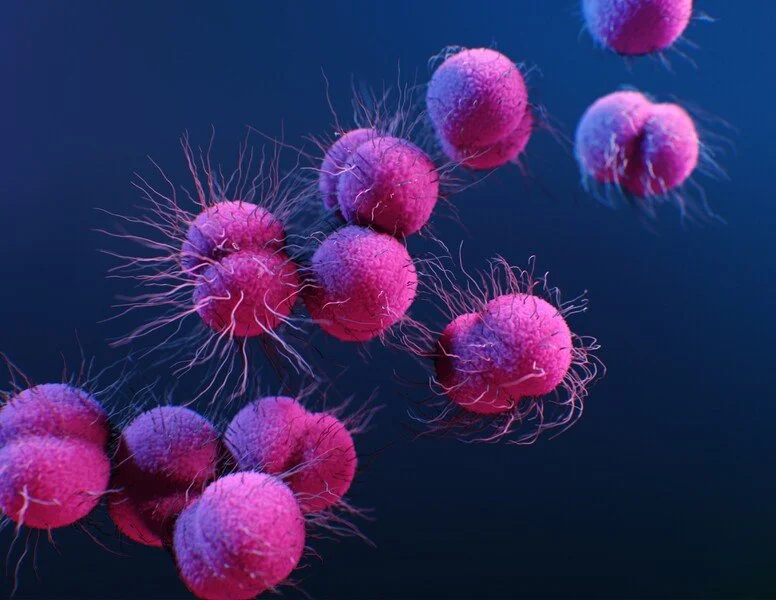Our ‘Lowest Life Forms’ Have a Higher Purpose
Photo by CDC
The human microbiome consists of trillions of bacteria, yeast, fungi and archaea residing in our mouths, nasal passages, skin, and -- primarily (95%) -- our gut.
It is estimated that approximately 1,000 different species of bacteria live in each human body, and that each of these species consists of about 2,000 genes, making sequencing of the human microbiome (2,000,000 unique genes) an order of magnitude more challenging than sequencing the human genome (~20,000 genes). (1) Accordingly, the NIH launched the Human Microbiome Project (HMP) in 2007 to begin the process of cataloging these microorganisms and discovering the unique roles they play -- both positive on negative -- on human health and disease states.
Since the launch of the HMP, a growing body of research has identified microbes that impact human health by being either beneficial, commensal (co-existing without harm to humans), symptomatic of disease states, or even contributors to disease states. To complicate matters, the same bacteria can adapt to have different strains and different impacts across individuals.
For example, heliobacter pylori has been associated with lower rates of mortality from lung cancer and stroke, and is thought to protect against childhood asthma. Nevertheless, another strain of heliobacter pylori claims responsibility for gastritis and most ulcers, and correlates with Parkinsons and a 40 times higher risk of developing stomach cancer. (2) Other research has found that autism is strongly linked to gut bacteria imbalances, with deficits of certain bacteria that help our bodies digest toxins that can otherwise alter brain development. (3) Still more research shows links between bacterial imbalances and dozens of other disease states, including obesity and diabetes.
In cases where specific microbes are correlated with disease states, researchers have found that these “microbial signatures” -- the relative balance of certain bacteria within the gut or blood stream -- may be among the body’s first discernible evidence of illness. For a number of cancers, changes in bacterial populations that are indicative of specific cancer types can be identified at low-grade tumor stages and before any altered tumor DNA appears in the bloodstream. (4)
Moreover, a growing number of clinical studies have demonstrated that purposefully altering the composition of our gut bacteria -- traditionally done through fecal transplants -- can improve a diverse range of conditions and disease states, and improve patients’ response rates to therapies including cancer treatments such as chemo and immunotherapy.
What Does the Future Look Like?
In the future, our ‘lowest life forms’ will be commonly appreciated as critical building blocks in our efforts to both diagnose and treat countless conditions, ranging from mild to severe.
Diagnose
Imagine a future where an annual check-up includes a stool sample analysis that tells you whether you may have the beginnings of colorectal, lung or pancreatic cancer. More moderately, the relative populations of bacteria in your gut may help identify autoimmune conditions, mental health concerns, or nutritional and metabolic disorders.
Scientists will have the computer power to be able to analyze -- rapidly and at scale -- our microbiome’s bacteria at the lowest taxonomic level in order to increasingly differentiate between the many positive and harmful effects that any given bacterium may play, and to understand how different bacterial populations interact with and influence one another.
Treat
While today’s popular conversation on bacteria is noisy with pseudo-science health and wellness claims made by companies touting unregulated over-the-counter prebiotics and probiotics, this is changing. The FDA is increasingly focused on building a framework to validate and regulate microbiome diagnostics and therapeutics.
Fecal transplants -- currently obtained via donation by a healthy donor, but difficult to use due to contamination from one or more species of undesirable bacteria -- will be replaced by personalized microbiome therapeutics, where each patient’s bacterial colony can be curated for optimal health and disease prevention.
Much as the Human Genome Project and advances in computing power ushered in the genetic revolution of the last two decades, the human microbiome offers the next frontier for deep exploration. Scientists and companies who can help us make sense of this fantastically complex universe -- and use that knowledge to tilt the world toward improved health and wellbeing -- will be among our next decade’s champions of impact.
Current Understanding of the Human Microbiome, Nature Medica, Gilbert, et al., Feb. 26, 2020.
Enders, Giulia. Gut: The Inside Story of Our Body’s Most Underrated Organ (Greystone Books, 2018), p.220.
People with Autism are Missing Certain Bacteria, Harvard University Science in the News, Oct. 29, 2020.
Poore, Gregory, et al. “Microbiome analyses of blood and tissues suggest cancer diagnostic approach”. Nature, Mar. 11, 2020.


